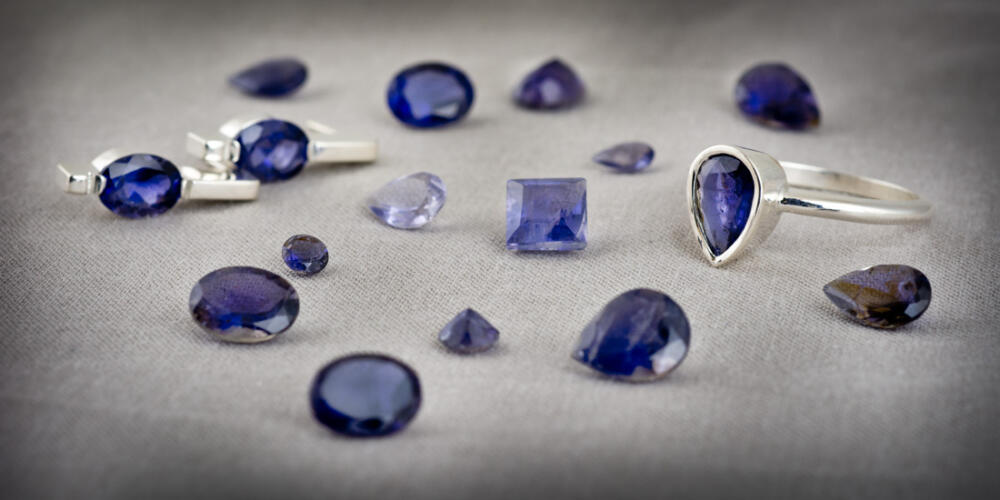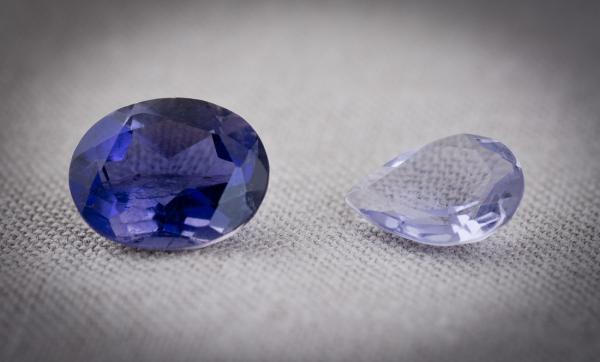Gem in the Spotlight: Iolite
Find your way to this violet beauty
Iolite is maybe not the first gemstone people think of for their blue-violet jewelry, but it should be near the top of the list. Iolite’s color range of blue, blue-violet, and violet competes for public attention with sapphire, tanzanite, and amethyst. They may have name recognition, but iolite has a rich, unique color and great gem value on its side. It is more subtlety nuanced than amethyst and deeper than many tanzanites.
Iolite’s name comes from its violet color. It is from the Greek word “ios” meaning violet. Unlike many other popular gems, iolite cannot be heat treated to enhance its color. The color you see is the natural color of the stone when it was first discovered. This adds value to many gem buyers who don’t want a treated gemstone.
Color Me Impressed
Iolite is strongly pleochroic and will exhibit a different color when viewed at different angles. Pleochroism is an optical phenomenon in which a substance appears to be different colors when observed at different angles, especially with polarized light. Pleochroism is caused by differing absorption of light rays in doubly refractive crystals. Thus, no singly refractive gemstone can exhibit pleochroism. The process works because of the ability of a gem to absorb different wavelengths of transmitted light depending upon its crystallographic orientations. Iolite is one of the most pleochroic gemstone used today.
It is iolite’s pleochroism that led to its most important historical use. Vikings used iolite slices to reduce glare when checking the sun’s position. The Vikings, according to Norse legend, used iolite called “The Viking Stone” as a polarizing filter to help them find the sun on cloudy days. They may have used a clearer, more transparent variety of the gemstone for this purpose. On a cloudy day, without being able to see the sun, iolite was used to find north.
This phenomenon can still be observed today. However, if you ever need to find north, I would recommend a different approach. Just use the finger that your iolite jewelry is worn on to open the compass app on your smart phone. From there you can find both magnetic north and true north. I would say that makes you a modern day Viking.
The Gemology of Iolite
Iolite is the gem variety of the mineral Cordierite. Iolite was once known as a “water sapphire”. Dichroite is another synonym for iolite. Dichroite is a Greek word which loosely translates as two-colored rock. This refers to iolite’s pleochroic nature.
iolite cannot be heat treated to enhance its color. The color you see is the natural color of the stone when it was first discovered.
Coming in at 7 to 7.5 on the Mohs hardness scale, iolite is a somewhat soft gem. It is comparable to quartz (Amethyst, Citrine, etc), a little harder than Opal, and softer than Emerald or Topaz. Because of this, some extra care should be taken with your iolite jewelry. Try to avoid wearing it in situations where it might be hit against hard objects to keep it free from cracks and small chips.
Iolite is a fairly common gem, found on at least 6 continents with large deposits in Australia, Brazil, India, and the United States. In fact, the largest known iolite was found in Wyoming, weighing in at a whopping 24,000 carats (that’s over 10 pounds)! This commonality helps keep the price of iolite very affordable making it an excellent choice for a beautiful yet budget friendly jewelry gift.
The Mythology of Iolite
Some of the lore surrounding iolite is enhanced by the Viking uses of the gem. Iolite is believed to convey a spiritual journey of dreams and exploration. Some see it as a way to provide the vision that moves us from the physical to the spiritual realm. Iolite’s property of pleochroism is thought of as a way of seeing different positions of reality or seeing two realms at the same time.
Other lore and myths about iolite include its use to help in recovering balance by those suffering from disorientation, lack of motivation, chronic disorganization, and distraction. Iolite is said to reinstate a sense of perspective to those who feel they are jinxed, and inspire anyone with a confused life to start to bring order in small, practical ways. It is also believed to aid the muses by activating the visionary, creative side of the mind inspiring self-expression through writing, song, movement, and other artistic endeavors.
Iolite is a special gemstone that is absolutely wonderful in jewelry. The subtle range of hues from blue to violet makes for elegant rings, pendants, and earrings. All in all, iolite is a great value and an amazing gem.


Iolite jewelry is a great choice. It absorbs colors and reflects them that make it more splendid. It helps you get over from distraction and gets converted into a self-motivated person. Iolite is a great value and a fantastic gem.
how available is Iolite?
Good question, Anne. Despite not being very popular in jewelry today, Iolite is actually readily available and quite affordable. We have a small selection available in our store, but we can also make new pieces using it in just about any size or shape that you want. 🙂
You say iolite cannot be color enhanced by heating–but can it be dyed? Thank you for this information.
Hi Mady, good question. I have not heard of dyed iolite, and I wasn’t able to find any records of natural iolite being dyed in a quick search. Iolite is not typically treated, so what you see is what came out of the ground (with a little help form a skilled gem cutter) most of the time.